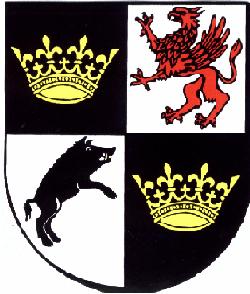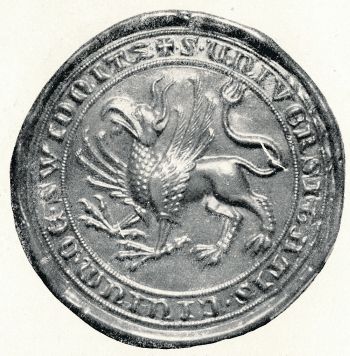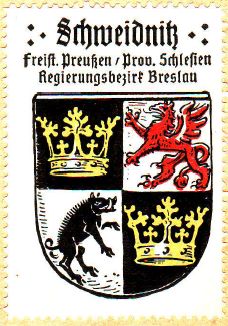Świdnica: Difference between revisions
Knorrepoes (talk | contribs) m (Text replacement - "{{poland}}" to "{{pl}}") |
Knorrepoes (talk | contribs) m (Text replacement - "{{pl}}↵ ↵'''" to "'''") Tags: Mobile edit Mobile web edit |
||
| (5 intermediate revisions by the same user not shown) | |||
| Line 1: | Line 1: | ||
'''ŚWIDNICA''' | '''ŚWIDNICA''' | ||
| Line 8: | Line 6: | ||
[[File:swidnic2.jpg|center]] | [[File:swidnic2.jpg|center]] | ||
===Origin/meaning=== | |||
The arms of the city (German name Schweidnitz) were supposedly granted in 1452 by King Ladislas of Poland. The oldest seal of the city, dating from 1284, only shows a griffin. The boar appeared on a smaller seal in 1355, they were combined on a seal known from 1400. According to legend this happened due to a long dispute over the animal which should symbolise the authorities of Swidnica - a griffin or a boar? At last it was resolved by King Waclaw Pogrobowiec who suggested that both of the symbols should be included in the coat of arms. As a reminder of that fact the crowns were added to the coat of arms.The historical colours show the first and fourth quarter in black, but during the second half of the 20<sup>th</sup> century the town used blue colours, see below. In the late 20<sup>th</sup> century the old colours were restored. | The arms of the city (German name Schweidnitz) were supposedly granted in 1452 by King Ladislas of Poland. The oldest seal of the city, dating from 1284, only shows a griffin. The boar appeared on a smaller seal in 1355, they were combined on a seal known from 1400. According to legend this happened due to a long dispute over the animal which should symbolise the authorities of Swidnica - a griffin or a boar? At last it was resolved by King Waclaw Pogrobowiec who suggested that both of the symbols should be included in the coat of arms. As a reminder of that fact the crowns were added to the coat of arms.The historical colours show the first and fourth quarter in black, but during the second half of the 20<sup>th</sup> century the town used blue colours, see below. In the late 20<sup>th</sup> century the old colours were restored. | ||
{|align="center" | {|align="center" | ||
|align="center"|[[File:swidnicaz2.jpg|center]] <br/>The seal from 1315 | |||
|align="center"|[[File:{{PAGENAME}}16.jpg|center|300 px|Arms of {{PAGENAME}}]] <br/>The arms in a [[:Category:Windhag city arms|16th century manuscript]] | |||
|- | |||
|align="center"|[[File:swidnicaz1.jpg|center]] <br/>A paper seal from around 1900 | |align="center"|[[File:swidnicaz1.jpg|center]] <br/>A paper seal from around 1900 | ||
|- | |- | ||
|align="center"|[[File:schweidnitz.hagd.jpg|center|Wappen von {{PAGENAME}}/Coat of arms (crest) of {{PAGENAME}}]] <br/>The arms by [[Otto Hupp|Hupp]] in the [[Kaffee Hag albums]] +/- 1925 | |||
|align="center"|[[File:swidnica.jpg|center]] <br/>The arms from around 1994 | |align="center"|[[File:swidnica.jpg|center]] <br/>The arms from around 1994 | ||
|} | |} | ||
[[Literature]] : Blue image obtained from Laszlo Szirtes, Hungary, upper image and background from Artur Bartlejewski and from from Hupp, O: [[Kaffee Hag albums]], 1920s. | [[Civic Heraldry Literature - Poland|'''Literature''']]: Blue image obtained from Laszlo Szirtes, Hungary, upper image and background from Artur Bartlejewski and from from Hupp, O: [[Kaffee Hag albums]], 1920s. | ||
[[Category:Polish Municipalities Ś]] | |||
[[Category:Dolny Śląsk]] | [[Category:Dolny Śląsk]] | ||
[[Category:Świdnica]] | [[Category:Świdnica]] | ||
Latest revision as of 10:50, 29 July 2024
ŚWIDNICA
Province: Dolny Śląsk
County : Świdnica
Origin/meaning
The arms of the city (German name Schweidnitz) were supposedly granted in 1452 by King Ladislas of Poland. The oldest seal of the city, dating from 1284, only shows a griffin. The boar appeared on a smaller seal in 1355, they were combined on a seal known from 1400. According to legend this happened due to a long dispute over the animal which should symbolise the authorities of Swidnica - a griffin or a boar? At last it was resolved by King Waclaw Pogrobowiec who suggested that both of the symbols should be included in the coat of arms. As a reminder of that fact the crowns were added to the coat of arms.The historical colours show the first and fourth quarter in black, but during the second half of the 20th century the town used blue colours, see below. In the late 20th century the old colours were restored.
| The seal from 1315 |
The arms in a 16th century manuscript |
| A paper seal from around 1900 | |
| The arms by Hupp in the Kaffee Hag albums +/- 1925 |
The arms from around 1994 |
Literature: Blue image obtained from Laszlo Szirtes, Hungary, upper image and background from Artur Bartlejewski and from from Hupp, O: Kaffee Hag albums, 1920s.





